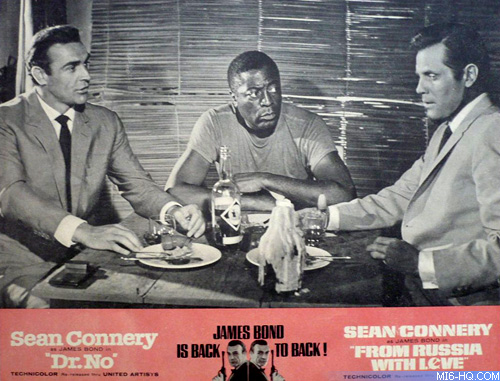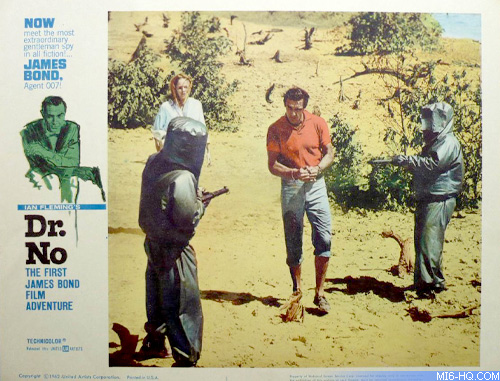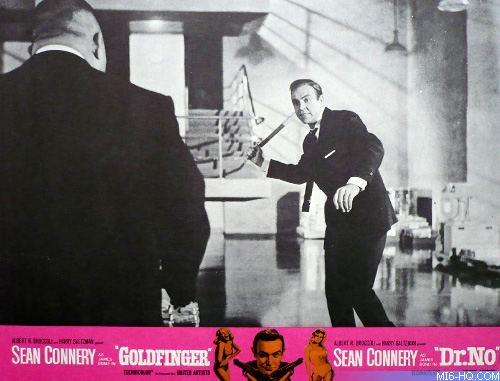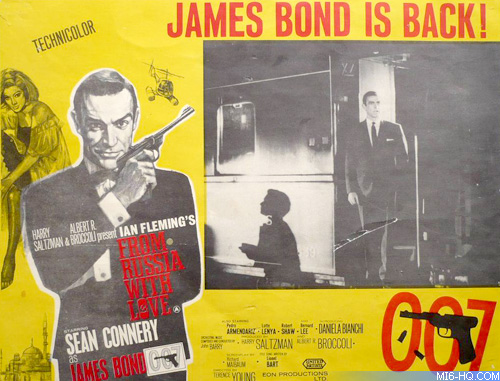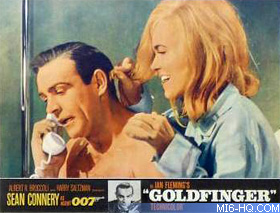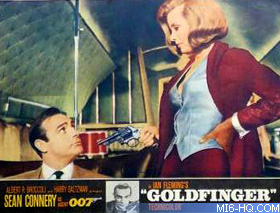Collecting 007 Lobby Cards (1)
14th May 2013
Guest writer Simon Firth offers a collector's perspective on the history of Bond's front of house marketing
 By Simon Firth
By Simon Firth
With collectors of James Bond memorabilia falling into two camps of those that look for licensed products, and those that collect the marketing material that promoted the film at the time of its release, certainly it is the latter arena that affords one the most chances to experience a sudden vacuum in available funds. While posters are the most obvious choice for collectors, it is the collecting of Lobby cards that, for the most part, remain comparatively moderate.
Lobby cards are 11x14 inch cards that are, as the name suggests, displayed in the lobby of the cinema. They aren't to be confused with the 10x8 inch FOH [Front Of House] cards that are displayed at the Front of House. It was mentioned that prices for these cards remain moderate. The trend amongst sellers and galleries of film memorabilia is to sell these cards as singles as opposed to complete sets as they were initially provided to the cinemas. Certainly this is an exercise in profiteering but if there is a market for this method of transaction, then one must assume it is there to be exploited.
This article refers only to the UK, US and English language International output - no comment can be made on European and foreign language International sets. The Bond series to this point in history (2013) numbers 25 official and unofficial films, and has produced a total of no less than 58 lobby card sets numbering over 450 cards.
|
It all started with "Dr. No" and, to start strong, this film came with what has become this author's favorite lobby set. Each card has a large image set to the right and a simple working of the poster graphic to the left with the title and poster byline. The cards are simple, well laid out and display the curious 60's need to tint, or ink in, everything to a colour different from what it was in the film. To wit, Bond's trousers in Jamaica in the film were blue - they were inked red for some of the cards. The same process can be seen applied to his shirt on occasion. The reason the stills were inked in was that for some reason, the National Screen Service, or NSS, was only ever given black & white stills to work from and it was up to the colourist to decide what best worked for the card. Indeed, they probably never even saw most of the films they worked on. Probably, this could be best exemplified by a Superman reissue lobby card from the TV series depicting Superman's tights as being mustard yellow - obviously they had never read the comic either. Even though the NSS numbers found on the bottom right of the card are 62/410, signifying that this was the 410th film in the year of 1962 to have advertising material created for it, the movie was not released in the US until May 1963.
|
Card 1 shows the daylight version of what became the day-for-night shot of Bond being captured by Dr No's dragon guards. No attempt was made to replicate the finished look of the film but then if trousers were not to match the wardrobe department's choice, one can assume this was of minor importance. The shots selected for the set are well chosen and all scenes appear in the final film.
"From Russia With Love" followed with a set that was photographed or printed in black and white and then tinted or washed to give it a red tinge. Various reasons for this have been offered but the most oft recurring one was that those responsible for the marketing wanted to push the political "red-ness" of the film. This would appear to be a credible reason as both the US 1 Sheet posters for the film also followed the black, white and red colour scheme. While the lobby images are generous in size, it nonetheless remains the least obviously glamorous of the series. The only outstanding point with this series is that there was a printing anomaly on some sets for two images which were assigned different card numbers: Bond in bed was printed as #3 and 4, the Helicopter chase was printed as #2 and 3.
|
This article had its genesis in 2005 and has been steadily added to as time, new information and new finds permit. Having been interested in the marketing of the Bond films for three decades, it is an unlikelihood that something would be unearthed that would be new to both this author and the likes of Graham Rye, of 007 Magazine and Archive. In 2013, a lobby card was purchased from eBay that broke those rules; a card from the film, "From Russia with Love" in poor condition that used the UK artwork to the left, on a yellow background and where the main still of FOH size was in b/w. Devoid of NSS and card numbering, strange implementations of the 007 logo of the time, an A rating and only one of the four girls from the UK art in evidence, its only clue as to its origins, as suggested by Mr Rye, was in the painting over and partial covering up of the girl in ways reminiscent of the Irish alterations to the Russia quad poster. A specially commissioned lobby card set for the Irish market? At present, it is unknown how many cards comprised this set; the accepted eight cards or, as below, similar to the UK sets of four? It is also unknown what other images were used for the remaining cards.
|
Colour was once again introduced for "Goldfinger" and "Thunderball" with sets that had generous sized images and the titling at the bottom. However, the Thunderball set was utilising inking to almost fluorescent proportions by this time and two of the cards had, what would appear to the casual observer as, images from scenes that weren't included in the film, namely Paula attacking all the frogmen with a knife and the scene with Largo briefing the men on the beach. They are actually posed publicity shots for the sole purpose of publicising the film. However, as they were used in the context of showing scenes from the film to the general cinema going public, they will continue to be referred to as unused scenes. In one card, Sir Sean is shown to be sporting a green scuba outfit; this due to similar reasons for colour anomalies as in the "Dr. No" set.
Two colour sets were produced by the UK for these films. They were both sets of four and utilised images from the UK FOH sets. The "Goldfinger" set carried no titling while the one for Thunderball had boxed titling in the bottom corners. In line with the aforementioned carving up of the universe and whose Producing name came first, Harry Saltzman was given the honour. The UK cards had a thicker quality to them and were also slightly glossy as opposed to their American counterparts.
A point of note is that the size of the photos for these cards from "From Russia With Love", "Goldfinger" and "Thunderball" were typical of this time. All lobby sets from UA were laid out in this fashion and the Bonds were treated the same as any other set.
|
"You Only Live Twice" was the first set to be printed in true colour as opposed to inked in or tinted colour - a lovely set with the artwork and titling once again reverting to the left. It was with "On Her Majesty's Secret Service" [OHMSS] that the designers took a departure from the norm by including a couple of cards depicting crew members at work - one was brushing lint from Telly Savalas' jacket; another showed cast and crew surveying a mountainside. Quite how this was supposed to add excitement to an advertising campaign for a film already suffering from on-set events is beyond understanding; perhaps it is just another example of the marketing mishaps pertaining to this film. That said, perhaps not so coincidentally. If one doesn't count a distant shot of him in the aforementioned photo of the crew on the mountainside, this lacklustre set features only two images of George Lazenby, and both of these present him in a kilt leading one to question whether there was an element of masochism on the part of the marketers. 'Against just how many inconceivable odds can we subject the success of this movie to?' Or, whether this was just sloppiness on the part of the designers or part of the overall campaign to de-emphasise the one-shot Bond actor; it is up to speculation. In 1967, Transamerica bought United Artists, a purchase that lasted for a period of 15 years and it is from the US release of OHMSS in 1970 that the Transamerica name started to make an appearance under the UA logo. "Diamonds Are Forever" offered a set of a competent style, the credits placed at the bottom of a smaller than previous image.
The size of the image photos from OHMSS through to "For Your Eyes Only" were all 10x8 for the simple reason that the NSS used the same photo plates to print both the US FOH stills and the lobby sets. Before this, as far back as 1955, NSS printed separate colour litho stills for most major films. These were of a high quality and were designed to be reprinted in magazines and to be used outside first run theatres. They came in sets of 12 and the scenes were different from the lobby cards. Since they were from original negatives the colours are rich and true to life. Sometime between 1968 and 1969, NSS decided to overhaul operations and cut back on material that wasn't being used that effectively or at all, so the printing of colour deluxe still sets was terminated. So from 1968 until 1985, with few exceptions, the US FOH stills and lobby cards printed at NSS were of the same scenes and 10x8 in size. The lobbies are just 10x8 stills with more generous borders. It would be fair to assume the same applied to the UK way of thinking when they took over production in 1985 as UK FOH stills are the same as the stills used for the lobbies.
Many thanks to Simon Firth. Stay tuned to MI6 for more Lobby Card commentary. All photographs graciously provided by the author.





